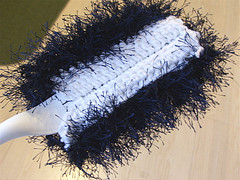
 Do you sometimes neglect to dust during your regular household cleaning chores? According to the Environmental Working Group (EWG), leaving dust around could do more than make your guests turn up their noses-it could be harmful to your health.
Do you sometimes neglect to dust during your regular household cleaning chores? According to the Environmental Working Group (EWG), leaving dust around could do more than make your guests turn up their noses-it could be harmful to your health.
Recent research has been delving into what exactly is in the dust that collects on our furniture, floors, and countertops. You probably already know that it contains traces of human skin, pet dander, hair, and the like. However, scientists at the Silent Spring Institute in Massachusetts examined indoor air dust in 120 homes, and found phthalates, phenylphenol (disinfectant), 4-nonylphenol (detergent metabolite), and flame retardants, even the carcinogenic intermediate of a flame retardant banned in 1977. (Flame retardants are now found in computers, TVs, and furniture.)
They also found 27 pesticides, including DDT, and reported that the concentrations exceeded government health-based guidelines for 15 of the compounds. These are all chemicals that have been linked to cancer, reproductive problems, and hormone disruption, by the way.
Another study conducted by health officials in Canada found lead in house dust, and warned of the dangers to young children, who swallow more contaminants because they often play on the floor and tend to put their hands in their mouths more often than adults. Scientists at the University of Arizona found that around 60 percent of floor dust comes from the soil tracked in on the bottom of our shoes. If someone lives or works near a contaminated site or industrial plant, the dust could contain toxins. Worse, indoor dust can contain more toxins than outdoor soil, because of the lack of wind, rain, and sunshine to break them down and whisk them away.
Most of us know that household dust can cause allergies. Now, with these reports coming out, we find it can also expose us to toxins that could negatively affect our health and the health of our children. This is in addition to the toxins we’re regularly exposed to in the environment, at our work places, and from daily products.
Though scientists have yet to determine the exact risk presented by these household toxins, we already know they’re not good for us. So how can you cut down on the contaminants in your home? The EWG recommends you take the following actions:
- Vacuum frequently with a machine that has a HEPA filter.
- Wet mop tile and wood floors to prevent dust from accumulating. (Dry mopping kicks up dust that can resettle.)
- Buy furniture that is filled with down, wool, polyester, or cotton as these are unlikely to contain added fire retardant chemicals.
- Regularly wipe furniture down with a wet or microfiber cloth, and stay away from synthetic sprays that only add more chemicals.
- Caulk and seal cracks and crevices in the home to prevent dust from coming in.
- Use filters on your forced-air heating and cooling systems and change them regularly.
- Regularly dust your electronic equipment.
- If you have children, pay special attention to their play areas.
- Leave your shoes at the door and use a natural doormat.
- If you have foam products made between 1970 and 2005-like stuffed/upholstered furniture, nursing pillows, padded high-chair seats, portable crip mattresses, baby changing pads, and chair cushions-replace anything with a ripped cover or foam that is breaking down, as these can contain fire retardant chemicals.
- Choose home electronics free of fire retardant chemicals-many manufacturers carry them now. Ask before you buy.
- Clean up thoroughly after any home-improvement project.
- When buying things that will “live” in your home, stick to natural products whenever you can, like wood, cotton, down, and wool.
- Consider getting a high-efficiency HEPA filter air cleaner for certain rooms in your home.
Have you become more conscientious about household dust? Please share your ideas.
Photo courtesy DuctTapeandDenim via Flickr.com.

